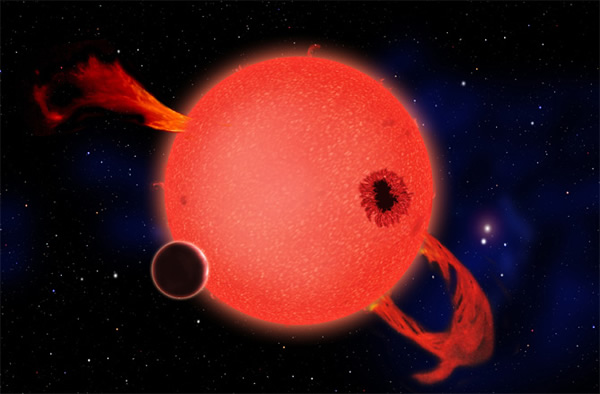Every Red Dwarf Hosts at Least One Exoplanet
Artist's impression of a small rocky world orbiting a flaring red dwarf star.
Red dwarf stars may be small, but they could be critical in the continuing hunt for exoplanets and the possibility of finding habitable alien worlds. In a new study, an international team of astronomers have estimated that every red dwarf in our galaxy hosts at least one exoplanet and that one quarter host super-Earths orbiting within their habitable zones.
The field of exoplanetary science has blossomed in recent years with the mind blowing discoveries by the Kepler space telescope and ever-increasing sophistication of ground-based observatories. Last week, Kepler’s exoplanetary haul skyrocketed with the announcement of 715 new confirmed worlds. But this is only the tip of the exo-iceberg. With improved observation techniques, more refined models and increasingly precise analytical tools, we can expect the steady stream of discoveries to turn into a deluge in the coming years.
And there’s one particularly intriguing target for astronomers — the lowly red dwarf.
These cool, dim, small stars are less than half the mass of our sun, but for what they lack in stellar energy they make up for in longevity. As they burn through hydrogen in their cores at a more pedestrian rate than their larger siblings, red dwarfs can persist for tens of billions or even trillions of years. Should a habitable world in orbit around a red dwarf spawn life, it would have billions of years to evolve.
Needless to say, this factor alone has inspired many theories about the potential for vastly intelligent lifeforms persisting far longer than our sun could ever support.
Signals in the Wobble
Now, astronomers from the UK and Chile have analyzed data from two high-precision exoplanet surveys — the High Accuracy Radial Velocity Planet Searcher (HARPS) at the La Silla Observatory and Ultraviolet and Visual Echelle Spectrograph (UVES) at the Very Large Telescope, both operated by the European Southern Observatory (ESO) and located in Chile.
Although both surveys are prolific exoplanet hunters in their own right, this new study combines data from both projects to tease out extremely faint signals of exoplanets that would have otherwise gone unnoticed. A healthy dose of statistical analysis was applied to tease out the exoplanet orbits from the noise.
Both projects detect the slight “wobble” exerted on a star as an unseen exoplanet orbits around it. The gravitational tug as the world orbits creates a tiny shift in the star’s position, a shift that can be detected in the starlight received by the instruments. As expected, high-mass worlds that orbit close to the star will create a strong signal, whereas small worlds orbiting further away will have a weaker signal. This method is known as the “radial velocity” technique for detecting exoplanets and it differs from Kepler’s “transit” method technique as it doesn’t require the exoplanet to pass in front of the star — thereby causing a slight ‘dip’ in brightness — to be detected.
Although Kepler is tailored to hunt for small worlds, that doesn’t mean ground-based instruments like HARPS and UVES can’t get in on the act; it just takes some ingenuity when analyzing the data.
“We were looking at the data from UVES alone, and noticed some variability that could not be explained by random noise,” said lead astronomer Mikko Tuomi, of the University of Hertfordshire. “By combining those with data from HARPS, we managed to spot this spectacular haul of planet candidates.”
“We are clearly probing a highly abundant population of low-mass planets, and can readily expect to find many more in the near future — even around the very closest stars to the Sun.”
Galactic Doorstep
In their paper to be published in the Monthly Notices of the Royal Astronomical Society (MNRAS), Tuomi’s team identified eight new exoplanets orbiting nearby red dwarf stars, three of which are ‘super-Earth’ sized worlds that orbit within their stars’ habitable zones. The habitable zone around any given star is the orbital distance at which a rocky planet could possess liquid water on its surface — the world is neither too hot or too cold for water to exist in a liquid state. Liquid water is required by life as we know it to evolve.
All of these new discoveries orbit red dwarfs between 15 and 80 light-years from our solar system, so on cosmic scales, they are on our galactic doorstep. They have orbital periods ranging from 4 days to 9 years, which equates to orbital distances of 0.05 to 4 times the sun-Earth distance.
The astronomers have also identified another ten exoplanetary candidates that require further investigation before they can be confirmed.
Although Kepler has noticed an abundance of small exoplanets in our galaxy, this study confirms that red dwarfs appear to have a near-certain chance of hosting at least one exoplanet. But most tantalizing is the probability that a quarter of those worlds are of super-Earth dimensions and orbit within the red dwarfs’ habitable zones.
But before we start getting too excited about dreams of ancient alien civilizations emerging from red dwarf star systems, it’s worth keeping in mind that red dwarfs may seem meek, but they certainly aren’t mild. They can be tumultuous little stars, generating some pretty nasty space weather that could stifle alien biology.(Mar 4, 2014 03:22 PM ET // by Ian O'Neill)












